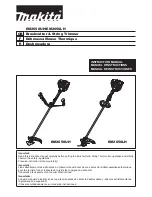
This is a publication by Conrad Electronic SE, Klaus-Conrad-Str. 1, D-92240 Hirschau (www.conrad.com).
All rights including translation reserved. Reproduction by any method, e.g. photocopy, microfilming, or the capture in electronic data
processing systems require the prior written approval by the editor. Reprinting, also in part, is prohibited. This publication represent
the technical status at the time of printing.
© Copyright 2014 by Conrad Electronic SE.
Installation and Connection
Please consult the section: “Safety Instructions”!
The LED downlight must be disconnected from the power supply during in-
stallation. It is not sufficient to just turn off the light switch!
First switch off all poles of the mains supply by removing the fuse or switch-
ing off at the circuit breaker and then also switch off the associated residual
current circuit breaker. Secure it against unauthorised reconnection, e.g.,
with a danger sign.
Check that the mains cable is free of current e.g. with an appropriate tester.
• The installation location for the LED downlight must be firm and stable.
• If several LED downlights are to be installed, plan the arrangement very carefully.
• Mark the required circle for the hole in the ceiling (for the required diameter, see
section “Technical Data”). With wood and gypsum plaster board the opening can be
cut out using a jig saw, for example.
Our tip:
When installing the LED downlight in a ceiling panel, check the correct hole
diameter on an off-cut in order to be sure of the size. Nothing is more frus-
trating than drilling a hole bigger than necessary in an expensive and high-
quality ceiling panel.
• Connect the mains cable to the LED driver of the LED downlight.
For this, you must first remove the plastic cover from the side of the LED driver,
located in the direction of the cable strain relief. To this end, loosen the screws used
to fasten the plastic cover and take the cover off.
• Furthermore, unfasten the bracket of the cable strain relief (by slightly unscrewing
the screws).
• Strip the wires of the mains cable (L/N) by approx. 5 mm.
• Attach the enclosed fiber-glass tube to the mains cable.
• Push the mains cable through the cable strain relief.
• Connect the mains cable (L/phase = brown cable, N/neutral wire = blue cable) to the
two big green screw terminals in the LED driver, see also labelling on the LED driver
(“PRI”).
The copper wires of the mains cable may have a cross-section of maximum
0.75 mm².
• Push the fiber-glass tube as much as possible towards the screw terminals.
• Replace the plastic cover that was removed previously and tighten it with the
screws.
• Tighten the screws of the cable strain relief such that the mains cable is securely
fastened together with the fiber-glass tube.
• Insert the LED downlight into the hole of the suspended ceiling.
If the three holding clamps are enclosed in
the package separately, insert them into the
brackets of the LED downlight as shown in
the right illustration.
Pivot the retaining bracket with the LED driver attached to it away to the side
so that the LED driver is not directly located above the cooling element of the
light after completed installation of the LED downlight.
Failure to do so may lead to the damage of the LED driver caused by over-
heating.
Insert the LED downlight into the hole of the suspended ceiling in such a manner
that the three spring clips of the light are securely fastened.
The long bracket shown in the illustration above has to be pushed through
the hole. The lower small bracket is clamped between the light and the ceil-
ing.
Important!
As previously described in the section “Safety Instructions”, the LED driver
and the LED downlight must not be embedded in heat insulating material
(e.g., heat insulation mats). With regard to the minimum distance, please pay
attention to the information in the “Technical data” section.
• Switch on the mains voltage and make sure that the LED downlight is functioning.
If the LED downlight is not lit up, switch off the mains voltage immediately
from all poles (take out the fuse or switch off the automatic circuit breaker,
switch off the earth fault circuit interrupter).
Then check the connection of the LED downlight.
In case of doubt, contact a professional (e.g. an electrician)!
Maintenance and Cleaning
The product is maintenance-free. Repair or maintenance work must be carried out by
a specialist. The LED bulbs used are permanently installed; they cannot be replaced.
You can use a clean, dry, soft cloth for cleaning. Dust can be very easily removed with
a soft, clean brush and a vacuum cleaner.
Do not use aggressive, chemical or scouring cleaning agents, as this may lead to dis-
colouration or changes in the material on the surface.
Disposal
The product must not be disposed of in the household waste.
Dispose of the product at the end of its serviceable life in accordance with
the current statutory requirements; e.g., return it to any suitable collection
point.
Technical Data
Operating voltage................................................... 220 - 240 V/AC, 50/60 Hz
Power consumption............................................... max. 21 W
Protection class ..................................................... II
Dimmable................................................................. no
Installation location ............................................... only in dry, enclosed indoor rooms
Operating conditions ............................................. Temperature 0 °C to +40 °C
...................................................................................
Air humidity 0% to 85% relative air hu-
midity, non-condensing
Light bulb ................................................................. 60 LEDs (firmly mounted, not replace-
able)
Light colour ............................................................. 3,000 K (Warm white)
Light flux .................................................................. 1,600 lm
Beam angle ............................................................. 85°
Dimensions (Ø x H)................................................. 247 x 92 mm
Installation depth ................................................... min. 90 mm, recommended >140 mm
due to heat development
Mounting hole Ø ..................................................... 212 mm
Material thickness at installation location ........ up to max. 40 mm
Distance to heat-insulating material .................. min. 10 cm
Weight ...................................................................... 1145 g


























